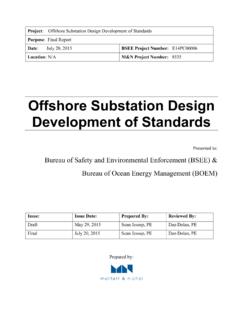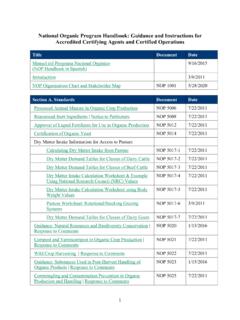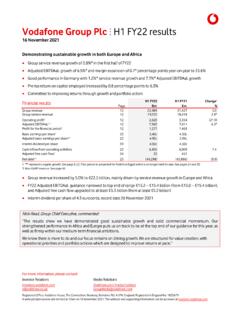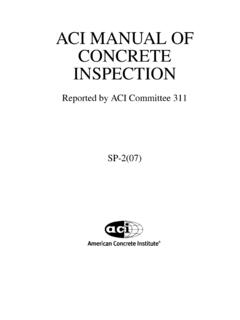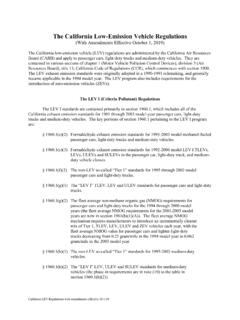Transcription of Appendix I – Air Emissions Calculations and Methodology
1 VOWTAP Research Activities Plan October 2014 Appendix I Air Emissions Calculations and Methodology AIR EMISSION Calculations AND Methodology Virginia Offshore Wind Technology Advancement Project (VOWTAP) Prepared for: 5000 Dominion Boulevard Glen Allen, VA 23060 Prepared by: Tetra Tech, Inc. 4101 Cox Road, Suite 120 Glen Allen, VA 23060 Submitted December 2013 Revised October 2014 VOWTAP Air Emission Calculations and Methodology TABLE OF CONTENTS 1 INTRODUCTION ..1 2 EMISSION CALCULATION METHODS ..1 Commercial Marine Vessels .. 1 Backup Power System .. 3 Nonroad Engines .. 4 Onroad Vehicles .. 5 GHG Emissions .. 5 3 REFERENCES ..6 TABLES Table 1. Summary of Harbor Craft and OGV Emission Factors, Corrected for 15 Parts per Million Sulfur Content in Harbor Craft and Percent Sulfur Content in OGVs .. 2 FIGURES Figure 1. NONROAD Model Input Options.
2 4 ATTACHMENTS Attachment A Emission Calculations Tetra Tech, Inc. Page i VOWTAP Air Emission Calculations and Methodology ACRONYMS AND ABBREVIATIONS Acronym Definition Btu British thermal units CH4 methane CMV commercial marine vessels CO carbon monoxide CO2 carbon dioxide CO2e carbon dioxide equivalents EPA Environmental Protection Agency gal gallons g grams g/hp-hr grams per horsepower hour g/kW-hr grams per kilowatt hour GHG greenhouse gas Emissions GWP Global Warming Potential HAP hazardous air pollutant hp horse power ICF ICF International kW kilowatt l/cyl liters per cylinder lb pounds MMBtu million British thermal units MOVES Motor Vehicle Emission Simulator NOX nitrogen oxides N2O nitrous oxide OGV ocean-going vessels ppmw part per million by weight SF6 sulfur hexafluoride SO2 sulfur dioxide particulate matter micrometers in diameter PM10 particulate matter 10 micrometers in diameter Project Virginia Offshore Wind
3 Technology Advancement Project VOC volatile organic compound VOWTAP Virginia Offshore Wind Technology Advancement Project Tetra Tech, Inc. Page ii VOWTAP Air Emission Calculations and Methodology 1 INTRODUCTION This report describes the Methodology applied to calculate the air Emissions associated with the Virginia Offshore Wind Technology Advancement Project (VOWTAP or Project), as well as the results of the Emissions Calculations , which are detailed in Attachment A. As described in Section of the VOWTAP Research Activities Plan, there are four primary categories of sources for which Emissions were calculated: Commercial marine vessels (CMVs), Backup power system, Nonroad engines, and Onroad vehicles. The specific air pollutants estimated from the above listed sources consist of the criteria air pollutants and greenhouse gases (GHGs). Specific pollutants in each group are listed as follows: Criteria Pollutants: o Nitrogen oxides [NOX], o Volatile organic compounds [VOC], o Carbon monoxide [CO], o Particulate matter 10 micrometers in diameter or less [PM10], o Particulate matter micrometers in diameter or less [ ], o Sulfur dioxide [SO2], and o Hazardous air pollutants [HAPs].
4 GHGs: o Carbon dioxide (CO2), o Methane (CH4), o Nitrous oxide (N2O), and o Sulfur hexafluoride (SF6). 2 EMISSION CALCULATION METHODS Methods for calculating criteria pollutant Emissions for the respective types of emission sources are summarized in Sections through Section below discusses the Methodology for estimating the total GHG Emissions for each of the sources. GHG Emissions are presented in CO2 equivalent or CO2e , because the different GHG constituents have different heat trapping capabilities. Commercial Marine Vessels The Environmental Protection Agency (EPA) guidance for CMV Emissions (ICF International 2009) categorizes tugboats, crew boats, etc. as harbor craft and categorizes larger engine ships as ocean-going vessels (OGVs), and identifies the emission factors shown in Table 1. For the purpose of estimating the CMV Emissions for the construction and operations phase of the VOWTAP commencing in 2017, Tier 1 emission factors for the smaller Category 1 engines and Tier 2 emission factors for the Category 2 engines were used providing a conservative estimate.
5 The harbor craft emission factors for SO2 and PM10 presented Tetra Tech, Inc. Page 1 VOWTAP Air Emission Calculations and Methodology in Table 3-8 of the ICF International (2009) report are based on a fuel sulfur content of percent. To adjust these factors for the 15 part per million by weight (ppmw) sulfur content in ultra-low sulfur diesel fuel, the ICF report factors were multiplied by and for SO2 and PM10, respectively, as recommended in Table 3-9: Harbor Craft Fuel Correction Factors from Offroad Diesel Fuel, of the ICF International (2009) report. Additionally, the emission factors for the larger engine OGVs for SO2 and PM10 presented in Table 2-9 of the ICF report are based on a fuel sulfur content of percent. These factors were adjusted to account for the percent sulfur content in marine diesel fuel to comply with International Maritime Organization Sulfur Emissions Control Area requirements discussed in the Air Quality section of the Research Activities Plan (Dominion 2014).
6 OGVs traveling from foreign ports are able to obtain marine diesel fuel with percent sulfur to use within the Emission Control Areas. However, vessels that fuel at ports will only have available ultra low sulfur diesel, containing no more than percent by weight. Table 1. Summary of Harbor Craft and OGV Emission Factors, Corrected for 15 Parts per Million Sulfur Content in Harbor Craft and Percent Sulfur Content in OGVs Minimum Power (kW) NOX (g/kW-hr) VOC (g/kW-hr) CO (g/kW-hr) PM10 (g/kW-hr) SO2 (g/kW-hr) CO2 (g/kW-hr) CH4 (g/kW-hr) N2O (g/kW-hr) Harbor Craft a/ Category 1 Tier 1 Engines 37 - 75 2 690 75 - 130 690 130 - 225 690 225 - 450 690 450 - 560 690 560 - 1000 690 1,000 + 5 690 Category 2 Tier 2 Engines 5 690 Ocean-going Vessels Category 3 b/ Main Engines All Categories Aux.
7 Engines Notes: a/ Category 1 engines have a displacement less than 5 liters per cylinder (L/cyl), Category 2 engines have a displacement greater than or equal to 5 (L/cyl) and less than 30 L/cyl, and Category 3 engines have a displacement greater than or equal to 30 L/cyl. b/ The emission factors for the Category 3 engines were based on a medium-speed diesel vessel using marine diesel oil fuel. In determining PM Emissions , it was assumed that all PM is less than 10 micrometers in diameter; therefore, the PM emission factor is equivalent to the PM10 emission factor. Additionally, based on EPA guidance presented in the report Exhaust and Crankcase Emission Factors for Nonroad Engine Modeling - Compression-Ignition (EPA 2010), is estimated to be 97 percent of PM10; therefore, the emission factor for is estimated based on the percentage of the PM10 presented in the ICF International (2009) report.
8 The emission factors used to estimate HAP emission for the CMVs utilized the Methodology identified in Table 104 of EPA s most current 2011 National Emissions Inventory report (EPA 2013a). The HAP emission factors used for the CMVs, presented in Table 104, refer to a specific dataset of factors provided Tetra Tech, Inc. Page 2 VOWTAP Air Emission Calculations and Methodology by EPA ( 2011 EPA_HAP-Augmentation ; EPA 2013b), and the HAP Emissions from CMVs are calculated from this dataset as a percentage of the PM10, , and VOC Emissions from the CMVs. The basic equation used to estimate annual Emissions from each CMV engine and activity is: E = kW Act LF EF Where: E = emission, grams/year kW = kilowatts (engine rating) Act = activity, hours/year LF = engine load factor (for the activity) EF = emission factor, g/kW-hr Because the emission factors in the ICF report are expressed in g/kW-hr, engine horsepower was converted to kilowatts by multiplying the horsepower by (one horsepower is equal to kilowatts).
9 The calculated Emissions were converted to tons per year by dividing the Emissions by the conversion factor from grams to pounds ( g/lb) and by the conversion factor from pounds to ton (2,000 lb/ton). The emission factors for harbor vessels are based on EPA marine engine Emissions standards ( , Tier 0 to Tier 3 based on cylinder displacement) and their respective EPA engine categories for CMV main propulsion engines and auxiliary engines. EPA established a tier structure for the emission standards based on age of the engine and cylinder displacement. Tier 0 (baseline), Tier 1, or Tier 2 are applicable to engines built prior to 2009. Stricter Tier 3 emission standards are applicable to engines built starting in 2009; however, as previously mentioned, for the purpose of estimating the CMV Emissions for the construction and operational phase of VOWTAP commencing in 2017, Tier 1 emission factors for the smaller Category 1 engines and Tier 2 emission factors for the Category 2 engines were used providing a conservative estimate.
10 The EPA categories for CMV engines are defined as follows: Category 1: 1-5 liters per cylinder displacement, Category 2: 5-30 liters per cylinder displacement, and Category 3: over 30 liters per cylinder displacement. The majority of the commercial harbor vessels, such as crew boats and security boats, have Category 1 engines. Some of the larger tugboats, jack-up-barges, and cable lay barge vessels have Category 2 engines. Category 1 engines have a range of emission factors depending on size; the highest values (for sizes < 1,000 kW) were conservatively chosen. Currently it is anticipated that the only Category 3 vessel will be the OGV transporting the turbines from Europe to the Project site. The CO2e (GHG) Emissions for the CMVs were calculated based on the Methodology presented in Section below. Backup Power System A major goal of VOWTAP is to develop and demonstrate strategies for offshore wind projects to survive hurricanes or other events that have the potential to bring down the electrical power grid.





